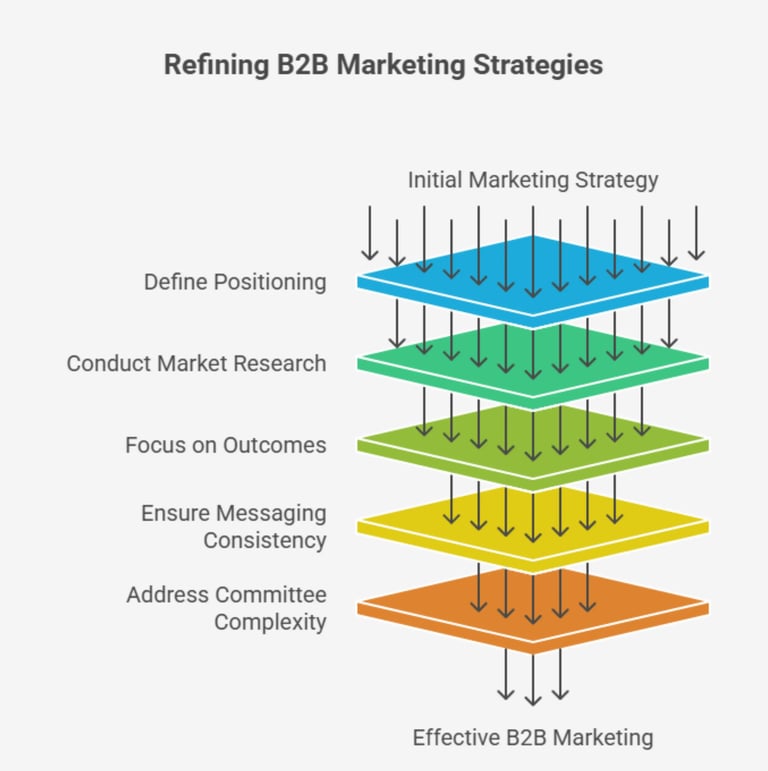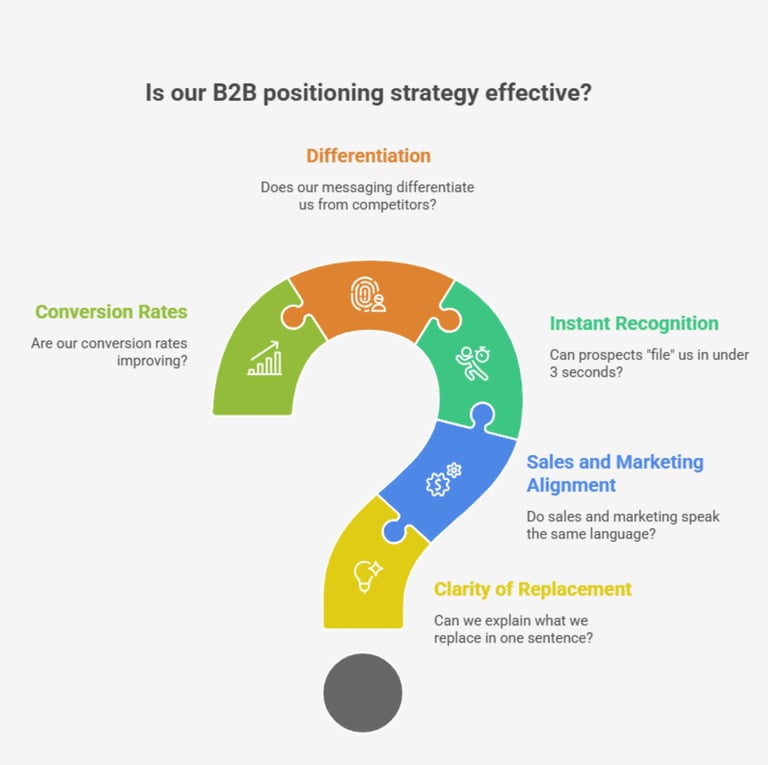B2B Positioning vs Messaging: The Real Reason Startups Fail at Go-to-Market Strategy
GROWTHSAAS
7/23/20256 min read


Positioning vs messaging – two terms that B2B founders throw around like they're the same thing. But here's the truth: they're not. And confusing them is costing you customers, lengthening your sales cycles, and burning through your marketing budget.
Remember Sony's Betamax? It was technically superior to VHS. But VHS won because it positioned itself as the default choice for video rentals. Sony focused on quality. VHS focused on fit. That positioning decision changed history.
Your startup faces the same choice every day. You can build the best product in the world, but if your market doesn't know where to "file" you mentally, you'll lose to competitors who get positioning right.
What's the Difference Between B2B Positioning and Messaging Strategy?
Think of positioning as your strategic foundation. It's how you define your unique place in the market and what you replace.
Messaging is how you communicate that position to the world.
Positioning: Your Strategic Foundation
Positioning is your internal compass that answers: "What do we replace?" and "Why do we matter now?"
It's strategic, rarely changes, and guides your entire company
Defines your unique market position and competitive differentiation
Messaging: Your External Communication
Messaging is your external voice through website copy, sales scripts, and email campaigns
It's tactical, constantly evolving, and speaks directly to your audience
Translates positioning into customer-facing communication
The relationship is simple: positioning comes first. Always.
Without clear positioning, your messaging becomes generic noise. With strong positioning, your messaging writes itself.
1. Treating Positioning and Messaging as the Same Thing
Most teams launch with headlines like "AI-powered productivity for teams" without ever defining what they actually replace.
The impact: Generic positioning leads to zero emotional connection and wasted ad spend.
The fix: Build your positioning strategy first. Then craft messaging that explains it clearly.
2. Skipping Deep Market Research and Customer Discovery
Here's what happens: founders assume they know their ideal customer profile (ICP). They don't validate it. They build messaging for the wrong audience.
The result: Low adoption rates and poor product-market fit.
The solution: Interview real prospects. Understand their triggers, objections, and buying processes before you write a single headline.
3. Leading with Features Instead of Customer Outcomes
You say "we automate workflows." Your buyer hears "cool, so does everyone else."
The damage: Unclear differentiation and low conversion rates.
The better approach: Speak in outcomes. "Save 10 hours per week." "Ship 3x faster." "Cut churn in half."
4. Inconsistent Messaging Across Marketing Channels
Your homepage says one thing. Your outbound emails say another. Your sales team tells a third story.
The cost: Market confusion, lost trust, and prospects dropping out of your funnel.
The fix: Create a single "positioning source of truth" that everyone uses consistently.
5. Ignoring B2B Buying Committee Complexity
B2B isn't one decision – it's a committee. Different stakeholders have different priorities and pain points.
The mistake: Creating one-size-fits-all messaging that speaks to no one effectively.
The solution: Develop specific messaging for each persona in the buying committee: the user, the buyer, the approver, and the potential blocker.
Some Popular B2B Positioning Case Studies:
Slack's B2B Positioning Masterclass
Problem they solved: Email overload
How they positioned: "Be less busy"
Result: 8,000 signups in 24 hours
Slack didn't just build a messaging app. They positioned themselves as the solution to a specific, painful problem everyone recognized.
Grammarly's Long-term B2B Positioning Strategy
Problem they solved: Writing anxiety
How they positioned: Your lifelong writing coach
Result: 30M+ users with seamless B2B expansion
Grammarly positioned itself as a partner in your success, not just a grammar checker.
Salesforce's Category Domination Through Positioning
Problem they solved: Scattered customer data
How they positioned: "The world's #1 CRM"
Result: Built trust and market leadership early
They claimed the top spot from day one and backed it up with industry-specific messaging.
Your Complete B2B Positioning Strategy Framework
Step 1: Define Your Market Position
Before you write any copy, answer these questions:
What exactly do you replace?
When do prospects need you most?
What makes you different from alternatives?
Who is your ideal customer?
Step 2: Craft Your Value Proposition
Your value proposition should:
Address a specific customer pain point
Highlight your unique benefits
Use clear, jargon-free language
Include social proof when possible
Step 3: Build Consistent Messaging Across Channels
Create messaging that:
Aligns with your positioning
Speaks to specific buyer personas
Focuses on outcomes, not features
Addresses objections proactively
Step 4: Test and Optimize Your Go-to-Market Strategy
B2B positioning and messaging isn't a one-time project. Monitor your metrics, gather feedback, and refine your approach based on real market response.
At BriskFab, we help B2B startups define their positioning wedge and translate it into messaging that actually converts. We recently helped a fintech client reposition from "faster onboarding" to "audit-ready onboarding in 5 minutes." Their close rate jumped 2.3x in 30 days.
How to Know If Your B2B Positioning Is Working
Run this quick checklist:
Can you explain what you replace in one sentence?
Do sales and marketing speak the same language?
Can prospects "file" you in their brain in under 3 seconds?
Does your messaging differentiate you from competitors?
Are your conversion rates improving?
If you answered "no" to any of these, your positioning needs work.
The Real Cost of Poor B2B Positioning Strategy
When your positioning is weak, everything else suffers:
Higher CAC: You need more spend to overcome market confusion
Longer sales cycles: Unclear messaging creates more objections
Lower conversion rates: Unclear benefits mean low urgency to act
Generic brand perception: You sound like "just another tool"
Internal misalignment: Teams drift without a shared narrative


The Bottom Line: Why B2B Positioning Drives Startup Success
Your startup doesn't need a better tagline. It needs a positioning strategy so sharp that your messaging becomes obvious.
Before you launch another ad campaign or send another email, ask yourself: Does your market know exactly what shelf to place you on – and why you're the only option worth considering?
Strong positioning makes everything else easier. Weak positioning makes everything else harder.
The choice is yours.
Ready to align your positioning and messaging before you scale? Book a call with BriskFab to define your GTM strategy and build messaging that converts.
Conclusion
Positioning vs messaging isn't just marketing theory – it's the difference between startups that scale and those that struggle. When you get positioning right first, your messaging becomes a powerful amplifier instead of expensive noise.
The companies that win aren't always the ones with the best products. They're the ones that help their market understand exactly why they matter and what they replace.
Your positioning strategy is your competitive advantage. Your messaging is how you communicate that advantage to the world.
Does your market know exactly where you fit – and why you're their best choice?
Frequently Asked Questions About B2B Positioning and Messaging
Q: What's the difference between positioning and messaging in B2B?
A: Positioning defines your strategic place in the market and what you replace. Messaging is how you communicate that position to your audience through copy, campaigns, and content.
Q: How often should I update my B2B positioning strategy?
A: Positioning should be stable and only updated with major business shifts. Review it every 6-12 months. Messaging should be continuously optimized based on market feedback.
Q: Can I fix my messaging without fixing positioning first?
A: Temporarily, yes. But long-term success depends on a clear positioning foundation. Without it, your messaging will always feel generic and fail to differentiate you.
Q: Who should own positioning in a B2B startup?
A: Founders or GTM leaders should own positioning. It's too strategic to delegate early. Messaging execution can be delegated once positioning is solid.
Q: How do I know if my B2B positioning is working?
A: Clear signs include: your team can explain what you replace consistently, prospects understand your value quickly, conversion rates improve, and you differentiate clearly from competitors.
Q: What's the biggest mistake founders make with positioning?
A: Conflating positioning with messaging. They jump straight to writing copy without first defining their unique market position, leading to generic messaging that doesn't resonate or convert.
Expert Summary
B2B positioning defines your strategic market position and what you replace, while messaging communicates that position to customers. The key insight: positioning must come first. Without clear positioning, messaging becomes generic noise that fails to differentiate. Common mistakes include treating them as the same thing, skipping market research, leading with features instead of outcomes, and creating inconsistent messaging across channels. Successful companies like Slack, Grammarly, and Salesforce won through sharp positioning strategies that helped markets understand exactly what they replaced and why they mattered.


